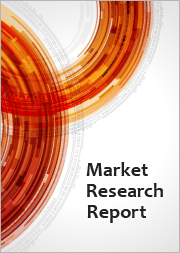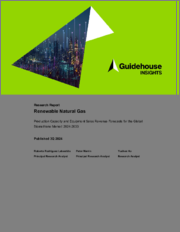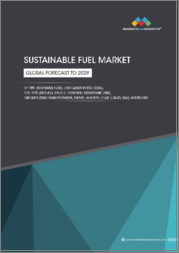
|
시장보고서
상품코드
1494791
세계의 바이오메탄 시장 예측 : 원료별, 제조 방법별, 용도별, 최종 사용자별, 지역별 분석(-2030년)Biomethane Market Forecasts to 2030 - Global Analysis By Feedstock (Organic Waste, Energy Crops, Sewage Sludge, Animal Manure, Industrial Waste, Food Processing Waste and Other Feedstocks), Production Method, Application, End User and By Geography |
||||||
Stratistics MRC에 따르면, 세계의 바이오메탄 시장은 2024년에 42억 8,000만 달러로 추정되고, 예측 기간 동안 CAGR은 10.8%로 성장할 전망이며, 2030년에는 63억 2,000만 달러에 이를 전망입니다.
바이오메탄은 신재생 천연가스(RNG)로도 알려져 있으며, 화석연료로부터 유래된 종래의 천연가스를 대체하는 지속가능한 대안입니다. 바이오메탄은 화학적으로 천연가스와 동일하며 기존의 가스 인프라에서 난방, 발전, 운송을 위해 호환적으로 사용할 수 있으며 신재생 저탄소 에너지원을 제공하며 잠재적 환경적 이익을 가져옵니다.
세계바이오가스협회(WBA)에 따르면 바이오가스는 세계 온실가스 배출량을 10-13% 삭감할 수 있어 세계 음식물쓰레기, 산업폐기물, 농업의 원료, 하수에서 신재생 에너지를 공급할 수 있습니다.
기후 변화 및 대기오염 우려 증가
화석연료의 소비가 환경에 미치는 영향에 대한 사회의 인식이 높아짐에 따라, 보다 깨끗한 신재생 에너지원에 대한 수요가 높아지고 있습니다. 유기폐기물 유래의 바이오메탄가스는 기존의 화석연료를 대체할 수 있는 지속가능한 대체에너지로 난방, 발전, 운송에 사용했을 때의 온실가스 배출량과 대기오염물질을 대폭 삭감합니다. 이러한 깨끗한 에너지원에 대한 의식의 고조와 수요는 기후 변화 완화 및 대기환경 개선에 크게 기여하는 것으로 바이오메탄 시장의 성장을 뒷받침하고 있습니다.
간헐적 공급
바이오메탄 생산에서 간헐적인 공급은 유기 원료의 가용성의 변동성과 계절성에 기인합니다. 작물의 성장이나 폐기물의 발생률에 영향을 미치는 날씨와 같은 요인이 이 예측 불가능성의 원인이 되고 있습니다. 이 간헐성은 일관되고 신뢰할 수 있는 바이오메탄 공급을 유지하기 위한 과제로, 에너지 생산과 분배의 신뢰성에 영향을 미칩니다. 나아가 이 불확실성이 잠재적인 투자자를 멀리하고 시장의 성장을 방해할 수도 있습니다.
지속 가능한 폐기물 관리 솔루션 도입
혐기성 소화 및 바이오가스화와 같은 지속가능한 폐기물 관리 솔루션의 도입은 바이오메탄 시장의 성장을 가속하는데 매우 중요한 역할을 합니다. 이러한 솔루션은 유기 폐기물을 매립지에서 전환하여 메탄 배출과 환경 오염을 줄입니다. 유기 폐기물을 바이오메탄 제조의 원료로 활용함으로써 이러한 공정은 폐기물 처리의 과제를 완화할 뿐만 아니라 귀중한 신재생 에너지 자원을 생산합니다. 그 결과, 풍부하고 다양한 원료 소스를 이용할 수 있어 바이오메탄 생산이 촉진되고, 시장 확대가 촉진되고, 보다 지속가능한 에너지의 미래로의 전환이 촉진됩니다.
바이오메탄 배포 및 이용을 위한 제한된 인프라
바이오메탄 배포 및 이용을 위한 인프라가 한정되어 있는 것은 가스 공급망의 주입 포인트나 연료 보급 스테이션 등 특수한 설비가 필요하기 때문입니다. 이러한 인프라 구축에는 많은 투자와 에너지 회사, 정부 기관, 운송업체 등 이해관계자간의 조정이 필요합니다. 이러한 인프라 부족은 에너지원으로서 바이오메탄에 대한 접근과 확장성을 제약하고 시장 성장을 방해합니다.
COVID-19의 영향
COVID-19의 유행은 당초 공급망 혼란, 프로젝트 지연, 경제 불확실성으로 인한 투자 감소로 바이오메탄 시장 성장을 둔화시켰습니다. 그러나 세계가 경기회복과 지속가능한 해결책에 주목하는 가운데, 바이오메탄을 포함한 신재생 에너지원에 대한 관심이 다시 높아지고 있습니다. 정부의 경기 자극책과 녹색 부흥 이니셔티브는 바이오메탄 인프라와 생산 시설에 대한 투자를 장려함으로써 시장 성장을 가속화할 수 있습니다.
예측기간 동안 유기폐기물 분야가 최대화될 전망
유기 폐기물 부문은 유리한 성장을 이루는 것으로 추정됩니다. 음식물 쓰레기, 농업 잔류물, 분뇨 등의 유기 폐기물은 바이오메탄 생산의 귀중한 원료로 사용됩니다. 혐기성 소화에 의해 미생물이 폐기물을 분해하여 주로 메탄으로 구성된 바이오가스를 생산합니다. 이 바이오가스를 정제함으로써 천연가스에 필적하는 신재생 에너지인 바이오메탄을 생산할 수 있습니다. 유기 폐기물을 바이오메탄에 이용하는 것은 환경 오염을 줄일 뿐만 아니라 지속 가능한 에너지 생산과 폐기물 관리에도 기여합니다.
예측 기간 동안 CAGR이 가장 높을 것으로 예상되는 것은 발전 분야
예측 기간 동안 CAGR이 가장 높을 것으로 예상되는 것은 발전 분야입니다. 바이오메탄은 지속가능한 연료원으로서 발전에 중요한 역할을 합니다. 이 용도에서는 바이오메탄을 가스 터빈이나 엔진으로 연소시켜 발전기를 구동하여 전력을 생산합니다. 바이오메탄의 사용은 화석연료에 비해 온실가스 배출을 줄이고 보다 깨끗한 에너지 생산에 기여합니다. 게다가, 바이오메탄은 기존의 송전망에 통합될 수 있어 환경에 미치는 영향을 줄이면서 증가하는 에너지 수요를 충족하는 신뢰할 수 있는 신재생 전력원을 제공할 수 있습니다.
최대 점유율을 차지하는 지역
예측 기간 동안 아시아태평양이 가장 큰 시장 점유율을 차지할 것으로 예측됩니다. 급속한 도시화, 인구 증가, 공업화에 의해 공해와 온실가스 배출에 대한 우려가 높아졌고, 각국 정부는 지속가능한 에너지 솔루션을 모색하게 되었습니다. 신재생 에너지를 촉진하는 정부의 정책은 환경문제에 대한 의식이 높아짐에 따라, 특히 중국, 인도, 일본 등의 국가에서 지역 전체의 바이오메탄 사업의 개발을 촉진하고 있습니다.
CAGR이 가장 높은 지역 :
환경 문제에 대한 관심 증가와 신재생 에너지로의 이동은 예측 기간 동안 유럽의 CAGR이 가장 높을 것으로 예측됩니다. 신재생 에너지의 도입을 촉진하는 엄격한 규제가 정부의 지원책과 함께 바이오메탄 생산시설에 대한 투자에 박차를 가하고 있습니다. 이 시장은 특히 독일, 영국, 스웨덴, 프랑스 등 국가에서 바이오메탄 제조 시설의 네트워크가 확대되고 있는 것이 특징입니다.
무료 맞춤설정 서비스
이 보고서를 구독하는 고객은 다음 무료 맞춤설정 옵션 중 하나를 사용할 수 있습니다.
- 기업 프로파일
- 추가 시장 기업의 종합적 프로파일링(3개사까지)
- 주요 기업의 SWOT 분석(3개사까지)
- 지역 세분화
- 고객의 관심에 응한 주요국 시장 추계, 예측 및 CAGR(주 : 타당성 확인에 따름)
- 경쟁 벤치마킹
- 제품 포트폴리오, 지리적 존재 및 전략적 제휴에 기반한 주요 기업 벤치마킹
목차
제1장 주요 요약
제2장 서문
- 개요
- 이해관계자
- 조사 범위
- 조사 방법
- 데이터 마이닝
- 데이터 분석
- 데이터 검증
- 조사 접근
- 조사 정보원
- 1차 조사 정보원
- 2차 조사 정보원
- 전제조건
제3장 시장 동향 분석
- 성장 촉진요인
- 억제요인
- 기회
- 위협
- 용도 분석
- 최종 사용자 분석
- 신흥 시장
- COVID-19의 영향
제4장 Porter's Five Forces 분석
- 공급기업의 협상력
- 구매자의 협상력
- 대체품의 위협
- 신규 진입업자의 위협
- 경쟁 기업간 경쟁 관계
제5장 세계의 바이오메탄 시장 : 원료별
- 유기성 폐기물
- 에너지 작물
- 하수 슬러지
- 동물의 비료
- 산업 폐기물
- 식품가공 폐기물
- 기타 원료
제6장 세계의 바이오메탄 시장 : 제조 방법별
- 혐기성 소화
- 가스화
- 열분해
- 화학적 메탄화
- 파워 투 가스(P2G)
- 기타 제조 방법
제7장 세계의 바이오메탄 시장 : 용도별
- 발열
- 발전
- 수송 연료
- 가스 그리드 주입
- 열전병급(CHP) 시스템
- 기타 용도
제8장 세계의 바이오메탄 시장 : 최종 사용자별
- 주택
- 상업
- 산업
- 운송
- 기타 최종 사용자
제9장 세계의 바이오메탄 시장 : 지역별
- 북미
- 미국
- 캐나다
- 멕시코
- 유럽
- 독일
- 영국
- 이탈리아
- 프랑스
- 스페인
- 기타 유럽
- 아시아태평양
- 일본
- 중국
- 인도
- 호주
- 뉴질랜드
- 한국
- 기타 아시아태평양
- 남미
- 아르헨티나
- 브라질
- 칠레
- 기타 남미
- 중동 및 아프리카
- 사우디아라비아
- 아랍에미리트(UAE)
- 카타르
- 남아프리카
- 기타 중동 및 아프리카
제10장 주요 발전
- 계약, 파트너십, 협업 및 합작투자(JV)
- 인수 및 합병
- 신제품 발매
- 사업 확대
- 기타 주요 전략
제11장 기업 프로파일링
- Wartsila Corporation
- Air Liquide
- Engie
- EnviTec Biogas AG
- Greenlane Renewables
- AB Energy
- PlanET Biogas Global GmbH
- Clarke Energy
- Future Biogas Limited
- Scandinavian Biogas
- BioConstruct GmbH
- MAPFRE SA
- SoCalGas
- Quantum Green
- Ameresco
- Renergon International AG
- StormFisher
- Verbio SE
- Weltech Biopower GmbH
- Magne Gas
According to Stratistics MRC, the Global Biomethane Market is accounted for $4.28 billion in 2024 and is expected to reach $6.32 billion by 2030 growing at a CAGR of 10.8% during the forecast period. Biomethane, also known as renewable natural gas (RNG), is a sustainable alternative to traditional natural gas derived from fossil fuels. Biomethane is chemically identical to natural gas and can be used interchangeably in existing gas infrastructure for heating, electricity generation, and transportation, offering a renewable and low-carbon energy source with potential environmental benefits.
According to the World Biogas Association (WBA), Biogas can reduce global GHG emissions by 10-13% and provide renewable energy from the world's food waste, industrial production wastes, feedstocks from agriculture, and sewage.
Market Dynamics:
Driver:
Growing concerns over climate change and air pollution
As societies become increasingly aware of the environmental impacts of fossil fuel consumption, there is a heightened demand for cleaner and renewable energy sources. Biomethane, derived from organic waste, offers a sustainable alternative to traditional fossil fuels, significantly reducing greenhouse gas emissions and air pollutants when used for heating, electricity generation, and transportation. This heightened awareness and demand for cleaner energy sources propel the growth of the biomethane market as a key contributor to mitigating climate change and improving air quality.
Restraint:
Intermittent supply
Intermittent supply in biomethane production stems from the variability and seasonality of organic feedstock availability. Factors like weather conditions affecting crop growth and waste generation rates contribute to this unpredictability. This intermittency poses challenges for maintaining a consistent and reliable biomethane supply, impacting the reliability of energy production and distribution. In turn, this uncertainty can deter potential investors and hinder market growth.
Opportunity:
Mounting sustainable waste management solutions
Mounting sustainable waste management solutions, such as anaerobic digestion and biogasification, play a pivotal role in propelling the growth of the biomethane market. These solutions divert organic waste from landfills, reducing methane emissions and environmental pollution. By utilizing organic waste as feedstock for biomethane production, these processes not only mitigate waste disposal challenges but also create a valuable renewable energy resource. Consequently, the availability of abundant and diverse feedstock sources fosters increased biomethane production, driving market expansion and facilitating the transition towards a more sustainable energy future.
Threat:
Limited infrastructure for biomethane distribution and utilization
Limited infrastructure for biomethane distribution and utilization arises due to the need for specialized facilities such as gas grid injection points and refuelling stations. The establishment of such infrastructure requires significant investment and coordination among stakeholders, including energy companies, government agencies, and transportation providers. This lack of infrastructure hampers market growth by constraining the accessibility and scalability of biomethane as an energy source.
Covid-19 Impact
The covid-19 pandemic initially slowed the growth of the biomethane market due to disruptions in supply chains, project delays, and reduced investments caused by economic uncertainty. However, as the world focuses on economic recovery and sustainable solutions, there's a renewed interest in renewable energy sources, including biomethane. Government stimulus packages and green recovery initiatives may accelerate market growth by incentivizing investments in biomethane infrastructure and production facilities.
The organic waste segment is expected to be the largest during the forecast period
The organic waste segment is estimated to have a lucrative growth. Organic waste, such as food scraps, agricultural residue, and manure, serves as a valuable feedstock for biomethane production. Through anaerobic digestion, microorganisms break down this waste, producing biogas primarily composed of methane. This biogas can then be refined to produce biomethane, a renewable energy source comparable to natural gas. Utilizing organic waste for biomethane not only mitigates environmental pollution but also contributes to sustainable energy production and waste management.
The electricity generation segment is expected to have the highest CAGR during the forecast period
The electricity generation segment is anticipated to witness the highest CAGR growth during the forecast period. Biomethane plays a crucial role in electricity generation by serving as a sustainable fuel source. In this application, biomethane is combusted in gas turbines or engines to drive generators, producing electricity. Its utilization reduces greenhouse gas emissions compared to fossil fuels, contributing to cleaner energy production. Additionally, biomethane can be integrated into existing power grids, providing a reliable and renewable source of electricity to meet the growing energy demands while mitigating environmental impact.
Region with largest share:
Asia Pacific is projected to hold the largest market share during the forecast period. Rapid urbanization, population growth, and industrialization have led to heightened concerns about pollution and greenhouse gas emissions, prompting governments to seek sustainable energy solutions. Government policies promoting renewable energy, coupled with growing awareness of environmental issues, are fostering the development of biomethane projects across the region, particularly in countries like China, India, and Japan.
Region with highest CAGR:
Europe is projected to have the highest CAGR over the forecast period, owing to increasing environmental concerns and the shift towards renewable energy sources. Stringent regulations promoting renewable energy adoption, coupled with supportive government incentives, have spurred investments in biomethane production facilities. The market is characterized by a growing network of biomethane plants, particularly in countries like Germany, the UK, Sweden, and France.
Key players in the market
Some of the key players profiled in the Biomethane Market include Wartsila Corporation, Air Liquide, Engie, EnviTec Biogas AG, Greenlane Renewables, AB Energy, PlanET Biogas Global GmbH, Clarke Energy, Future Biogas Limited, Scandinavian Biogas, BioConstruct GmbH, MAPFRE S.A., SoCalGas, Quantum Green, Ameresco, Renergon International AG, StormFisher, Verbio SE, Weltech Biopower GmbH and Magne Gas.
Key Developments:
In May 2024, Air Liquide has taken another step forward in sustainable biomethane production by implementing an internal charter, developed with experts and WWF France. Specifically, the charter is centred around four main pillars: contributing efficiently to the energy transition; serving as a lever for agro ecological practices; maximising the benefits for local ecosystems and promoting a circular economy; and preserving biodiversity and preventing environmental risks.
In June 2023, MAPFRE, alongside its partner Abante and IAM Carbonzero, launched the fund MAPFRE Energias Renovables II, FCR. As an innovative project in the European context, it will invest in biomethane, a 100% green biofuel obtained from animal and vegetable waste that can be injected directly into the natural gas grid, generate electricity via engines, and be used as a fuel.
Feedstocks Covered:
- Organic Waste
- Energy Crops
- Sewage Sludge
- Animal Manure
- Industrial Waste
- Food Processing Waste
- Other Feedstocks
Production Methods Covered:
- Anaerobic Digestion
- Gasification
- Pyrolysis
- Chemical Methanation
- Power-to-Gas (P2G)
- Other Production Methods
Applications Covered:
- Heat Generation
- Electricity Generation
- Transportation Fuel
- Gas Grid Injection
- Combined Heat and Power (CHP) Systems
- Other Applications
End Users Covered:
- Residential
- Commercial
- Industrial
- Transportation
- Other End Users
Regions Covered:
- North America
- US
- Canada
- Mexico
- Europe
- Germany
- UK
- Italy
- France
- Spain
- Rest of Europe
- Asia Pacific
- Japan
- China
- India
- Australia
- New Zealand
- South Korea
- Rest of Asia Pacific
- South America
- Argentina
- Brazil
- Chile
- Rest of South America
- Middle East & Africa
- Saudi Arabia
- UAE
- Qatar
- South Africa
- Rest of Middle East & Africa
What our report offers:
- Market share assessments for the regional and country-level segments
- Strategic recommendations for the new entrants
- Covers Market data for the years 2022, 2023, 2024, 2026, and 2030
- Market Trends (Drivers, Constraints, Opportunities, Threats, Challenges, Investment Opportunities, and recommendations)
- Strategic recommendations in key business segments based on the market estimations
- Competitive landscaping mapping the key common trends
- Company profiling with detailed strategies, financials, and recent developments
- Supply chain trends mapping the latest technological advancements
Free Customization Offerings:
All the customers of this report will be entitled to receive one of the following free customization options:
- Company Profiling
- Comprehensive profiling of additional market players (up to 3)
- SWOT Analysis of key players (up to 3)
- Regional Segmentation
- Market estimations, Forecasts and CAGR of any prominent country as per the client's interest (Note: Depends on feasibility check)
- Competitive Benchmarking
- Benchmarking of key players based on product portfolio, geographical presence, and strategic alliances
Table of Contents
1 Executive Summary
2 Preface
- 2.1 Abstract
- 2.2 Stake Holders
- 2.3 Research Scope
- 2.4 Research Methodology
- 2.4.1 Data Mining
- 2.4.2 Data Analysis
- 2.4.3 Data Validation
- 2.4.4 Research Approach
- 2.5 Research Sources
- 2.5.1 Primary Research Sources
- 2.5.2 Secondary Research Sources
- 2.5.3 Assumptions
3 Market Trend Analysis
- 3.1 Introduction
- 3.2 Drivers
- 3.3 Restraints
- 3.4 Opportunities
- 3.5 Threats
- 3.6 Application Analysis
- 3.7 End User Analysis
- 3.8 Emerging Markets
- 3.9 Impact of Covid-19
4 Porters Five Force Analysis
- 4.1 Bargaining power of suppliers
- 4.2 Bargaining power of buyers
- 4.3 Threat of substitutes
- 4.4 Threat of new entrants
- 4.5 Competitive rivalry
5 Global Biomethane Market, By Feedstock
- 5.1 Introduction
- 5.2 Organic Waste
- 5.3 Energy Crops
- 5.4 Sewage Sludge
- 5.5 Animal Manure
- 5.6 Industrial Waste
- 5.7 Food Processing Waste
- 5.8 Other Feedstocks
6 Global Biomethane Market, By Production Method
- 6.1 Introduction
- 6.2 Anaerobic Digestion
- 6.3 Gasification
- 6.4 Pyrolysis
- 6.5 Chemical Methanation
- 6.6 Power-to-Gas (P2G)
- 6.7 Other Production Methods
7 Global Biomethane Market, By Application
- 7.1 Introduction
- 7.2 Heat Generation
- 7.3 Electricity Generation
- 7.4 Transportation Fuel
- 7.5 Gas Grid Injection
- 7.6 Combined Heat and Power (CHP) Systems
- 7.7 Other Applications
8 Global Biomethane Market, By End User
- 8.1 Introduction
- 8.2 Residential
- 8.3 Commercial
- 8.4 Industrial
- 8.5 Transportation
- 8.6 Other End Users
9 Global Biomethane Market, By Geography
- 9.1 Introduction
- 9.2 North America
- 9.2.1 US
- 9.2.2 Canada
- 9.2.3 Mexico
- 9.3 Europe
- 9.3.1 Germany
- 9.3.2 UK
- 9.3.3 Italy
- 9.3.4 France
- 9.3.5 Spain
- 9.3.6 Rest of Europe
- 9.4 Asia Pacific
- 9.4.1 Japan
- 9.4.2 China
- 9.4.3 India
- 9.4.4 Australia
- 9.4.5 New Zealand
- 9.4.6 South Korea
- 9.4.7 Rest of Asia Pacific
- 9.5 South America
- 9.5.1 Argentina
- 9.5.2 Brazil
- 9.5.3 Chile
- 9.5.4 Rest of South America
- 9.6 Middle East & Africa
- 9.6.1 Saudi Arabia
- 9.6.2 UAE
- 9.6.3 Qatar
- 9.6.4 South Africa
- 9.6.5 Rest of Middle East & Africa
10 Key Developments
- 10.1 Agreements, Partnerships, Collaborations and Joint Ventures
- 10.2 Acquisitions & Mergers
- 10.3 New Product Launch
- 10.4 Expansions
- 10.5 Other Key Strategies
11 Company Profiling
- 11.1 Wartsila Corporation
- 11.2 Air Liquide
- 11.3 Engie
- 11.4 EnviTec Biogas AG
- 11.5 Greenlane Renewables
- 11.6 AB Energy
- 11.7 PlanET Biogas Global GmbH
- 11.8 Clarke Energy
- 11.9 Future Biogas Limited
- 11.10 Scandinavian Biogas
- 11.11 BioConstruct GmbH
- 11.12 MAPFRE S.A.
- 11.13 SoCalGas
- 11.14 Quantum Green
- 11.15 Ameresco
- 11.16 Renergon International AG
- 11.17 StormFisher
- 11.18 Verbio SE
- 11.19 Weltech Biopower GmbH
- 11.20 Magne Gas



















